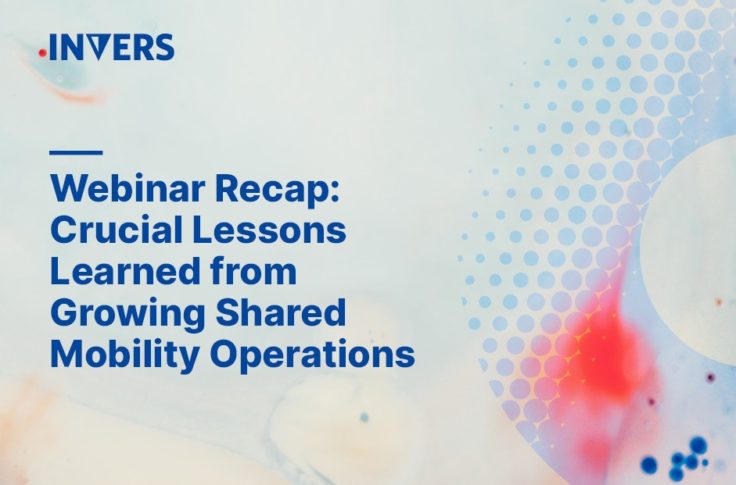How to Run a Scooter Sharing Business – the Strategic Way
Summary
Scaling up scooter sharing operations takes a disciplined and structured approach. This can include evaluating key priorities, working with cities and data regulations, and developing your own competitive advantage. By understanding the complexities of scooter sharing , you will be better equipped for long-term success.

The recent buzz surrounding scooter sharing (ie: kick scooters, e-scooters, etc.) has focused on the viability of this business model. In response to concerns about vehicle safety, durability, and longevity, scooter sharing operators have eased off rapid expansion plans. Instead, operators are now figuring out the puzzle on how to achieve and maintain long-term profitability.
In order to scale and grow a scooter sharing business, operators need to do more than just focus on unit economics. Fortunately, we can take a page from what made carsharing and moped sharing successful when it was still in its infancy and apply similar strategic approaches to this popular form of micromobility.
Strategy #1: Understand the Payoff
In an ideal world, scooter sharing companies alike would launch world-class, cost-efficient operations in cities of all shapes and sizes. However, the reality is that running a fleet of shared vehicles is a challenging endeavor. Sandra Phillips of movmi points out, “Free floating carshare, such as car2go, didn’t have the luxury of dropping thousands of vehicles without a proper parking strategy into cities. They had to implement geo-fences to support parking needs and restrictions.”
Substantial capital is also needed to purchase scooters and connected IoT, permits are needed to operate legally, and human resources are needed to get the service running. We’ve seen that being first-to-market does not always translate to market success. Instead, it takes a disciplined and structured approach to achieve scalable operations.
The basic principles of the triple constraint apply to the world of micromobility. The triple constraint highlights the payoffs between cost, scope, and time. In the context of scooter sharing, this means:
Constraint
Completing the project faster (time) will increase capital needed to launch (cost)
Micromobility Context
Focusing on a quick time-to-market is costly. This could be due to substantial marketing spend to build awareness, not fully evaluating all vendor options and paying high switching costs later, or struggling with the cost of losing revenue for not choosing a more reliable technology solution.
Adding another product feature (scope) will require more pre-launch preparation (time)
Features like dynamic pricing or offering more than one vehicle type is great, but that means more logistics to figure out. As a result, this could delay your launch. The 5 key steps to get started in micromobility focuses on keeping things simple. Once you have a strong foundation in place, then you can start advancing your offering and value to customers.
Making the project cheaper (cost) will likely mean a reduction of deliverables (scope)
Starting a new venture like scooter sharing can be costly. You may be tempted to cut costs wherever possible, such as finding a low-cost sharing solution. You get what you pay for, and that can result in reduced reliability, capabilities, and limitations on how to scale up your value proposition to users.
As a result, it is important to understand what the strategic priorities are and determine the best course of action to move forward. A great example is from the City of Calgary, who tracked accidents during their micromobility pilot and found that the majority of accidents happen with first time riders. Sandra Phillips of movmi adds, “Again, something we know from other shared mobility services: 40% of new users struggle with their first ride. Learning a new form of transportation takes time, and inexperienced riders need education.”
To succeed long-term, success shouldn’t come in the form of short-term peaks. While expanding to new cities may represent growth of market share, if operations cannot be sustained due to cost or operational inefficiencies, then any gain in user base and market share will be wasted. Instead, the idiom “slow and steady wins the race” becomes very relevant. Understanding the local mobility culture and political constraints, while building partnerships with key stakeholders, will help support service longevity for steady growth.
Strategy #2: Remove Barriers to Data Sharing
For many operators, trip data is treated like secret information that only key people should have access to. The rationale is that trip data reveals competitive information like utilization and revenue, or it creates data privacy issues. However, these concerns can be addressed through regulations. As a result, trip data becomes accessible to better understand the benefits of scooter sharing and shared mobility in general. Without access to real data, cities will be less effective in proactively identifying road space needs of these micro vehicles. Data is also critical to provide quantitative evidence on how shared scooters are filling the short distance mobility needs.
Current specifications like the Mobility Data Specification (MDS) by Los Angeles’ Department of Transportation requires more information from operators on vehicle usability, such as any maintenance or recharging needs. This standard is being adapted to global markets like Bogotá, Columbia, and European markets like France and UK are starting to develop their own new mobility laws as well. The additional challenge to consider is the European Union’s General Data Protection Regulation (GDPR) and its impact on the use of personal data.
Complying with data specifications may seem more like a hassle and a barrier to growing your shared operations quickly. But it is important to remember that city officials determine whether you even get to operate in the first place. Cities are working on balancing the operator need to run a profitable business while ensuring citizen’s mobility needs are being met. For example, Washington DC used tools to ensure scooters were consistently serving lower income communities. In Switzerland, the Swiss Federal Railways shares open data to challenge data enthusiasts to come up with new solutions.
Pro-tip: Data sharing shouldn’t be hard. If your operating software is built for flexibility, then it should not be a burden to open up or share certain pieces of data with cities directly or through third party tools like Populus or Remix. Shared mobility software that is built with well-documented APIs and webhooks will support the growing demand for data sharing from cities.
On the flip side, sharing data easily can also be a competitive advantage for operators. The easier it is to integrate third party tools to your operating system, the more capabilities you can add in your scooter sharing service. Tools that use artificial intelligence to indicate where vehicles have higher revenue potential would be a helpful tool to have, as long as data can be shared in real-time. Similarly, if you are looking to integrate a certain amount of your fleet into a MaaS app, you can control how many vehicles get shared with the right data build in place.
Strategy #3: Realize Your Competitive Intelligence
Once you nail down a strong foundation for scooter sharing and have a better idea on how to operate a fleet of electric scooters, you can then focus on identifying and highlighting your competitive advantage. Learning by doing – in this case running shared scooters – gives you the insight and experience needed to truly understand what you need to make your service stand out. This competitive intelligence needs to translate into value-driven features that will further encourage retention of users.
In other words, the next building block of being competitive with scooter sharing is to develop your own business logic. While there are best practices on how to grow successfully, such as the aspects we have pointed out so far, there are still variances within each operation. Only you will understand the needs of your top users. Only you will know which neighbourhoods respond better to cross-promotions. Leverage these factors and customize your operations.
The platform you run your shared service on needs to be flexible and modular, so you can integrate your desired features and add more value to customers. If you are restricted to a generic full-stack solution and its defined feature set, your strategic growth plans won’t go very far. Instead, you need a platform that lets you pick and choose different features and allows you to easily modify the feature set as needed.
From a technical point of view, look out for a shared mobility solution that is built with a well-documented API. While open APIs are common practice, having it organized in a developer-friendly way will make it much easier for you to implement your ideas and make it come to life. Another great feature to look out for in your scooter sharing solution is webhooks. While APIs are great in retrieving data, webhooks take it to the next level by automating the call for data. As a result, webhooks can make your micromobility service feature-rich without much hassle.
5 Facts About Running a Scooter Sharing Business
Scooter sharing is fun for users, but complex behind-the-scenes. Let’s recap the top 5 points we just covered:
- Complexity: Succeeding in micromobility is about more than unit economics. The complexities of having shared e-scooters on the street requires operators to identify strategies that will support their growth towards long-term profitability.
- Payoffs: Just because launching shared e-scooters is less costly to launch than shared cars, doesn’t mean that success is easier to achieve. There are payoffs between cost, scope, and time that play a critical role in how you decide to grow.
- Longevity: Short-term peaks in success are not a true indicator of long-term growth. Understanding the local mobility culture, building partnerships, and reducing operational inefficiencies will support service longevity.
- Data: When it comes to data, sharing is caring! Usage data helps cities be more proactive in developing favorable regulations, while also providing quantitative evidence on the impact of scooter sharing and other forms of micromobility.
- Competition: Leverage your operational experience and the insight you have on your users to develop value-driven features and extend your competitive advantage. Make sure to have a modular technology backbone, so you have maximum flexibility in what features to develop.


